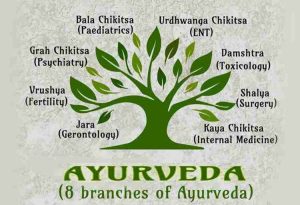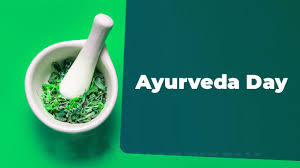The Government of India has designated September 23rd as the annual Ayurveda Day, starting from the year 2025.
September 23rd marks the autumnal equinox, representing a natural balance that echoes Ayurveda’s fundamental philosophy of equilibrium in the body, mind, and spirit.
Ayurveda Day is a national observance dedicated to honoring India’s ancient system of medicine, promoting it as a scientifically grounded and holistic health tradition.
SIGNIFICANCE OF AYURVEDA DAY:
- Awareness and Education: It aims to raise awareness about the principles of Ayurveda, its benefits, and its role in preventive healthcare.
- Promotion of Traditional Medicine: The day highlights the importance of traditional medicine systems in the modern healthcare landscape.
- Research and Innovation: It encourages research in Ayurvedic practices and the development of new treatments and therapies.
- Community Engagement: Various events, workshops, and health camps are organized to engage the community and promote wellness.
CELEBRATIONS & ACTIVITIES:
On Ayurveda Day, numerous activities take place across the country:
- Health Camps and Free Consultations: Ayurvedic practitioners offer free consultations and treatments to the public.
- Workshops and Seminars: Experts conduct sessions to educate people about Ayurvedic practices, diet, and lifestyle.
- Cultural Programs: Events showcasing traditional music, dance, and rituals related to Ayurveda are organized.
- Distribution of Medicinal Plants: People are encouraged to plant and care for medicinal herbs, promoting sustainable health practices.
ABOUT AYURVEDA:
Ayurveda is an ancient Indian system of medicine that originated from the Vedas, particularly the Atharva Veda, over 5000 years ago. The term Ayurveda comes from “Ayu” (life) and “Veda” (knowledge), which together mean “Science of Life.”
Core Principles:
- Swasthasya Swasthya Rakshanam: Preserving the health of the healthy.
- Aturasya Vikara Prashamanam: Treating the illness of the sick.
- Focuses on maintaining balance between the body, mind, spirit, and the environment.
- Healing through natural methods, including herbs, diet, lifestyle adjustments, and therapeutic practices.
Features of Ayurveda:
- Prioritizes preventive care rather than reactive treatments.
- Promotes harmony between the mind and body and encourages seasonal health routines.
- Utilizes herbal medicines, detox therapies, yoga, and meditation.
Tailors health strategies based on an individual’s unique constitution (Prakriti).
One of the fundamental aspects of Ayurveda is that it is divided into eight primary branches, each focusing on a specific area of health. These branches offer a wide range of treatments and approaches, with each one contributing to the holistic healing process.
Here’s an overview of the eight branches of Ayurveda:

- Kaya Chikitsa (General Medicine)
- Focus: General health and disease management.
- Purpose: Kaya Chikitsa is concerned with the treatment of common diseases and disorders affecting the body and mind. It includes lifestyle changes, diet, herbal remedies, detoxification techniques, and Ayurvedic medicines.
- Key Treatments: Panchakarma (detoxification), dietary modifications, herbal treatments, and rejuvenation therapies.
- Scope: Kaya Chikitsa is the most widely practiced branch of Ayurveda, focusing on preventive, curative, and regenerative therapies.
- Shalya Tantra (Surgery)
- Focus: Surgical procedures and treatments.
- Purpose: This branch deals with surgical techniques, including operations, dressing of wounds, and surgical management of diseases like fractures and abscesses.
- Key Treatments: Surgical interventions, bone-setting, and wound healing. Historically, it also included procedures like cataract surgery.
- Scope: Shalya Tantra emphasizes the importance of precise, careful surgical intervention and is often combined with herbal remedies for faster recovery.
- Shalakya Tantra (ENT, Ophthalmology, and Dentistry)
- Focus: Treatments related to the eyes, ears, nose, throat, and dental care.
- Purpose: This branch focuses on diagnosing and treating diseases of the sensory organs and includes practices related to eye care, dental issues, and conditions affecting the ears, nose, and throat.
- Key Treatments: Eye care treatments (like Netra Tarpana), dental hygiene (like Dantamala), nasal treatments (like Nasya), and therapies for the ear and throat.
- Scope: Shalakya Tantra is essential for managing chronic ailments like cataracts, sinusitis, and dental decay, using a combination of natural therapies and surgical interventions.
- Kumarbhritya (Pediatrics)
- Focus: Child health and diseases.
- Purpose: This branch specializes in the care of children, focusing on their growth, nutrition, and treatment of pediatric diseases.
- Key Treatments: Ayurvedic formulations for children’s health, including treatments for childhood diseases, growth disorders, nutritional imbalances, and infant care.
- Scope: Kumarbhritya emphasizes the delicate nature of children’s health and the use of gentle, safe herbal remedies and therapies to support healthy development.
- Graha Chikitsa (Psychiatry)
- Focus: Mental health and disorders.
- Purpose: Graha Chikitsa is the branch of Ayurveda dedicated to the treatment of mental illnesses and psychiatric disorders, often believed to be caused by imbalances in the mind-body connection or negative energies (grahas).
- Key Treatments: Herbal remedies, meditation, yoga, detoxification, and spiritual practices aimed at restoring mental harmony.
- Scope: It addresses a wide range of mental health issues, from anxiety and depression to more severe conditions like schizophrenia, emphasizing holistic and natural therapies for mental well-being.
- Rasa Shastra (Alchemy and Pharmacology)
- Focus: Preparation of medicinal compounds, particularly with metals and minerals.
- Purpose: Rasa Shastra involves the preparation of Ayurvedic medicines using metals, minerals, and gemstones in addition to herbs. The emphasis is on the purification and processing of these substances to make them safe and effective for therapeutic use.
- Key Treatments: Medicinal formulations (Rasas), which include herbal extracts, as well as compounds made from mercury, sulfur, and other metals. These are designed for a variety of treatments, including detoxification and rejuvenation.
- Scope: Rasa Shastra is vital for the creation of potent medicines and tonics used for a variety of conditions, especially those requiring deep detoxification and powerful rejuvenating therapies.
- Vajikarana (Aphrodisiac Therapy)
- Focus: Sexual health, vitality, and reproduction.
- Purpose: Vajikarana deals with enhancing sexual health, vitality, and reproductive functions. It includes therapies for improving libido, fertility, and overall sexual wellness.
- Key Treatments: Herbal aphrodisiacs, tonics for sexual health, dietary recommendations, and lifestyle changes aimed at balancing reproductive health.
- Scope: Vajikarana therapies are particularly focused on balancing the sexual and reproductive systems, improving vitality, and treating infertility or low libido, often through the use of natural herbs and tonics.
- Rasayana (Rejuvenation Therapy)
- Focus: Promoting longevity and rejuvenating the body.
- Purpose: Rasayana aims to rejuvenate the body, mind, and spirit, improving vitality and promoting long-term health and longevity. This branch focuses on slowing down the aging process and increasing strength, immunity, and mental clarity.
- Key Treatments: Rasayana therapies include the use of rejuvenating herbs, dietary guidelines, detoxification, and lifestyle practices that help restore youthful energy and promote longevity.
- Scope: This branch is vital for promoting health and vitality in all stages of life, focusing on holistic rejuvenation and maintaining a healthy, active lifestyle.
The eight branches of Ayurveda provide a well-rounded approach to maintaining health and treating illness. From general medicine to surgery, pediatrics, psychiatry, and rejuvenation, Ayurveda offers a comprehensive system of healthcare that balances the body, mind, and spirit.
GLOBAL RECOGNITION:
Ayurveda’s influence extends beyond India:
- International Collaborations: India collaborates with countries like Fiji and Nepal to promote Ayurveda globally.
- WHO Recognition: The World Health Organization has acknowledged Ayurveda as a traditional medicine system, integrating it into the International Classification of Diseases (ICD-11).
- Educational Initiatives: Several universities worldwide offer courses and degrees in Ayurvedic medicine, reflecting its growing global acceptance.
The official declaration of 23rd September as Ayurveda Day marks a significant step in recognizing and promoting the ancient science of Ayurveda.
This fixed date will facilitate better planning and participation in events, ensuring that the principles of Ayurveda reach a broader audience. As we celebrate this day, it’s an opportunity to reconnect with our roots, embrace natural healing practices, and promote a balanced and healthy lifestyle.



